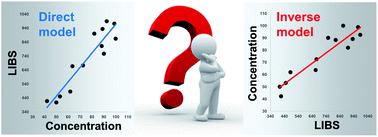当前位置:
X-MOL 学术
›
J. Anal. At. Spectrom.
›
论文详情
Our official English website, www.x-mol.net, welcomes your feedback! (Note: you will need to create a separate account there.)
Should we prefer inverse models in quantitative LIBS analysis?
Journal of Analytical Atomic Spectrometry ( IF 3.4 ) Pub Date : 2020-03-09 , DOI: 10.1039/c9ja00435a Ludovic Duponchel 1, 2, 3, 4, 5 , Bruno Bousquet 5, 6, 7, 8, 9 , Frédéric Pelascini 5, 10, 11 , Vincent Motto-Ros 5, 12, 13, 14, 15
Journal of Analytical Atomic Spectrometry ( IF 3.4 ) Pub Date : 2020-03-09 , DOI: 10.1039/c9ja00435a Ludovic Duponchel 1, 2, 3, 4, 5 , Bruno Bousquet 5, 6, 7, 8, 9 , Frédéric Pelascini 5, 10, 11 , Vincent Motto-Ros 5, 12, 13, 14, 15
Affiliation

|
Since the 2000s, the analytical potential of laser-induced breakdown spectroscopy (LIBS) has been growing steadily. This is explained by the many advantages it provides such as its sensitivity, its speed of acquisition, but also the possibility of analyzing most samples as they are without preparation. Like many spectroscopies in the framework of quantitative analysis, LIBS uses the concept of indirect measurement to estimate the concentration of an element of interest in a given matrix. Thus, in the simplest case of univariate calibration, the emission signal at a particular wavelength is used as an input of a simple linear regression to obtain the associated concentration. This regression is one of the oldest statistical tools that can be used to make the link between two variables. On the basis of the calibration samples, the LIBS community is used to construct the function f, such as emission signal = f(concentration). With this so-called direct model, the prediction of the concentration of an unknown sample is then obtained by calculating f−1 (emission signal). This habit may be very surprising because many spectroscopies nowadays use the so-called inverse model. Thus, in this case, another function g is calculated from the same data set, such as concentration = g(emission signal). In this specific case, the function can be used directly to predict the concentration of a new sample. At first glance, we could say that this is not very important because it is the same as reversing the axis of abscissa and ordinate in a two-dimensional graph. In this paper, we will show that this choice is not insignificant because it may lead to statistical differences. Through the study of simulations and real cases, we will demonstrate that a difference in the predictive ability is observed between the direct and inverse regression in the framework of LIBS quantitative analysis.
中文翻译:

在定量LIBS分析中,我们应该采用逆模型吗?
自2000年代以来,激光诱导击穿光谱法(LIBS)的分析潜力一直在稳步增长。这可以通过它提供的许多优势来解释,例如灵敏度,采集速度,以及无需准备就可以分析大多数样品的可能性。像定量分析框架中的许多光谱学一样,LIBS使用间接测量的概念来估计给定基质中目标元素的浓度。因此,在单变量校准的最简单情况下,特定波长的发射信号被用作简单线性回归的输入以获得相关的浓度。这种回归是最古老的统计工具之一,可用于在两个变量之间建立联系。根据校准样品,f,例如发射信号= f(浓度)。利用这种所谓的直接模型,然后通过计算f -1(发射信号)来获得未知样品浓度的预测。这个习惯可能非常令人惊讶,因为如今许多光谱学都使用所谓的逆模型。因此,在这种情况下,根据同一数据集计算另一个函数g,例如浓度= g(发射信号)。在这种特定情况下,该函数可直接用于预测新样品的浓度。乍一看,我们可以说这不是很重要,因为它与在二维图中反转横坐标轴和纵坐标轴相同。在本文中,我们将证明此选择并不重要,因为它可能导致统计差异。通过对模拟和实际案例的研究,我们将证明在LIBS定量分析的框架中,正向和反向回归之间的预测能力存在差异。
更新日期:2020-04-24
中文翻译:

在定量LIBS分析中,我们应该采用逆模型吗?
自2000年代以来,激光诱导击穿光谱法(LIBS)的分析潜力一直在稳步增长。这可以通过它提供的许多优势来解释,例如灵敏度,采集速度,以及无需准备就可以分析大多数样品的可能性。像定量分析框架中的许多光谱学一样,LIBS使用间接测量的概念来估计给定基质中目标元素的浓度。因此,在单变量校准的最简单情况下,特定波长的发射信号被用作简单线性回归的输入以获得相关的浓度。这种回归是最古老的统计工具之一,可用于在两个变量之间建立联系。根据校准样品,f,例如发射信号= f(浓度)。利用这种所谓的直接模型,然后通过计算f -1(发射信号)来获得未知样品浓度的预测。这个习惯可能非常令人惊讶,因为如今许多光谱学都使用所谓的逆模型。因此,在这种情况下,根据同一数据集计算另一个函数g,例如浓度= g(发射信号)。在这种特定情况下,该函数可直接用于预测新样品的浓度。乍一看,我们可以说这不是很重要,因为它与在二维图中反转横坐标轴和纵坐标轴相同。在本文中,我们将证明此选择并不重要,因为它可能导致统计差异。通过对模拟和实际案例的研究,我们将证明在LIBS定量分析的框架中,正向和反向回归之间的预测能力存在差异。



























 京公网安备 11010802027423号
京公网安备 11010802027423号